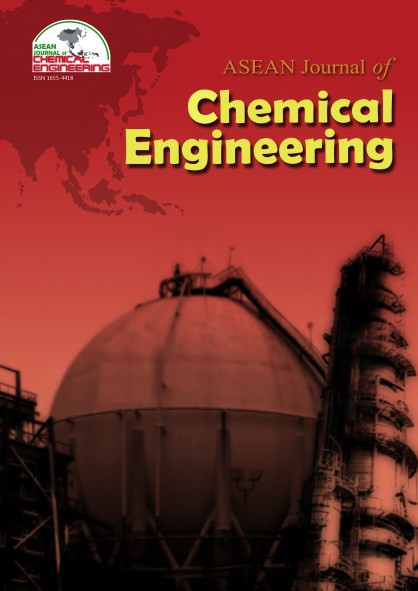Mass Transfer of Natural Dye Extraction and the Degradation Rate
Abstract
This research studied the effect of temperature on the mass transfer rate and degradation rate of natural dye extraction. As the representative, two natural dyes extracted from Senduduk and Susupan Gunung plants were employed. Senduduk and Susupan Gunung are weed plants that are often found in peatlands. Susupan Gunung is easily found in South Kalimantan, and local people use it as a natural dye for handicraft products. Senduduk is often found in the South Sumatra area also used as a natural dye for traditional fabrics. Senduduk and Susupan Gunung were extracted in a three-neck flask using water as a solvent at temperatures of 50°, 70°, and 90°C. Samples of the extract solution were taken at certain times until the tannin concentration was constant. The tannin concentration in the solution was analyzed using volumetric methods. Experimental data consists of tannin concentrations in solution at various times. The mass transfer coefficient, equilibrium constant, and tannin degradation rate constant were determined by minimizing the sum square of errors between experimental data and the model. Senduduk contains more tannin (0.0094 g/cm3 solution) than Susupan Gunung (0.0079 g/cm3 solution), and Senduduk has a higher mass transfer coefficient than Susupan Gunung. The higher the temperature, the greater the rate of tannin degradation. During the extraction process, extract of Senduduk and Susupan Gunung leaves are stable at 50°C, which tends to degrade faster at higher temperatures.
References
Abilleira, F., Varela, P., Cancela, Á., Álvarez, X., Sánchez, Á., and Valero, E., 2021. “Tannins extraction from Pinus pinaster and Acacia dealbata bark with applications in the industry.” Ind. Crops Prod., 164, 113394.
Al-Farsi, M.A., and Lee, C.Y., 2008. “Optimization of phenolics and dietary fibre extraction from date seeds.” Food Chem., 108, 977–985.
Binti Rosli, N.A., Ibrahim, W.A., Hassan, Z., and Bin Sofian, A.H., 2019. “Tropical Tannin for Engineering Application.” Indones. J. Chem., 20, 248.
Febriana, I.D., Kusuma, H.S., Gala, S., and Mahfud, M., 2016. “The effect of temperature on extraction of Swietenia mahagoni by ultrasound–assisted extraction (UAE) method.” ASEAN Journal of Chemical Engineering, 16, 44–49.
Guerrero, M.S., J. Sineiro Torres, J.S., and Nunez, M.J., 2008. “Extraction of polyphenols from white distilled grape pomace: Optimization and modelling.” Bioresource Technology, 99(5),1311-1318.
Hussain, I., Sanglard, M., Bridson, J.H., and Parker, K., 2020. “Preparation and physicochemical characterisation of polyurethane foams prepared using hydroxybutylated condensed tannins as a polyol source.” Ind. Crops Prod., 154, 112636.
Kilpeläinen, P., Liski, E., and Saranpää, P., 2023. “Optimising and scaling up hot water extraction of tannins from Norway spruce and Scots pine bark.” Ind. Crops Prod., 192, 116089.
Koodkaew, I., Senaphan, C., Sengseang, N., and Suwanwong, S., 2018. “Characterization of phytochemical profile and phytotoxic activity of Mimosa pigra L.” Agric. Nat. Resour., 52, 162–168.
Liana, I., Astirin, O.P., and Nugraheni, E.R., 2015. “Aktivitas antimikroba fraksi dari ekstrak metanol daun senggani (Melastoma candidum) terhadap Staphylococcus aureus dan Sa. typhimurium serta profil kromatografi lapis tipis fraksi teraktif.” Biofarmasi, 13, 66–77.
Lim, Y.Y., and Murtijaya, J., 2007. “Antioxidant properties of Phyllanthus amarus extracts as affected by different drying methods.” LWT - Food Sci. Technol., 40, 1664–1669.
Luo, X., Bai, R., Zhen, D., Yang, Z., Huang, D., Mao, H., Li, X., Zou, H., Xiang, Y., Liu, K., Wen, Z., and Fu, C., 2019. “Response surface optimization of the enzyme-based ultrasound-assisted extraction of acorn tannins and their corrosion inhibition properties.” Ind. Crops Prod., 129, 405–413.
Mindaryani, A., Sujoto, V.S.H., Silalahi, S.C.M., Petrus, H.T.B.M., and Rahayuningsih, E., 2023. “Drying of merbau (Intsia bijuga) sawdust extract: Effect of temperature on the quality of natural dye product.” Indones. J. Chem. 23, 1445-1455.
Nurwahyuwono, D.E., Afrienty, V.E., Soemargono, and Nove Kartika Erliyanti, N.K., 2021. “Mass transfer coefficient of extraction tannin compounds from papaya leaves with 96% ethanol solvent.” Konversi 10(1), 52 – 57.
Petchidurai, G., Nagoth, J.A., John, M.S., Sahayaraj, K., Murugesan, N., and Pucciarelli, S., 2019. “Standardization and quantification of total tannins, condensed tannin and soluble phlorotannins extracted from thirty-two drifted coastal macroalgae using high performance liquid chromatography.” Bioresour. Technol. Reports, 7, 100273.
Sari, A.P., Amanah, N.L., Wardatullathifa, A., and Nugroho, A., 2022. “Comparison of Maseration and Sonication Method on Flavonoid Extraction from Mango Leaves: Effect of Solvent Ratio.” ASEAN Journal of Chemical Engineering, 22, 274–283.
Silva, E., Rogez, H., and Larondelle, Y., 2007. “Optimization of extraction of phenolics from Inga edulis leaves using response surface methodology.” Sep. Purif. Technol., 55, 381–387.
Susanti, D.Y., Sediawan, W.B., Fahrurrozi, M., and Hidayat, M., 2019. “A mechanistic model of mass transfer in the extraction of bioactive compounds from intact sorghum pericarp.” Processes, 7, 837.
Wang, S., Chen, F., Wu, J., Wang, Z., Liao, X., and Hu, X., 2007. “Optimization of pectin extraction assisted by microwave from apple pomace using response surface methodology.” J. Food Eng., 78, 693–700.
Yuniati, Y., Dhiya Dini Azmi, Eric Nurandriea, Lailatul Qadariyah, Mahfud, 2023, Parametric study and characterization of sappan wood (Caesalpinia sappan Linn) natural red colorant extract with ultrasonic assisted extraction method, ASEAN Journal of Chemical Engineering, 23 (1), 103-112

This work is licensed under a Creative Commons Attribution-NonCommercial 4.0 International License.
Copyright holder for articles is ASEAN Journal of Chemical Engineering. Articles published in ASEAN J. Chem. Eng. are distributed under a Creative Commons Attribution-NonCommercial 4.0 International (CC BY-NC 4.0) license.
Authors agree to transfer all copyright rights in and to the above work to the ASEAN Journal of Chemical Engineering Editorial Board so that the Editorial Board shall have the right to publish the work for non-profit use in any media or form. In return, authors retain: (1) all proprietary rights other than copyright; (2) re-use of all or part of the above paper in their other work; (3) right to reproduce or authorize others to reproduce the above paper for authors’ personal use or for company use if the source and the journal copyright notice is indicated, and if the reproduction is not made for the purpose of sale.


